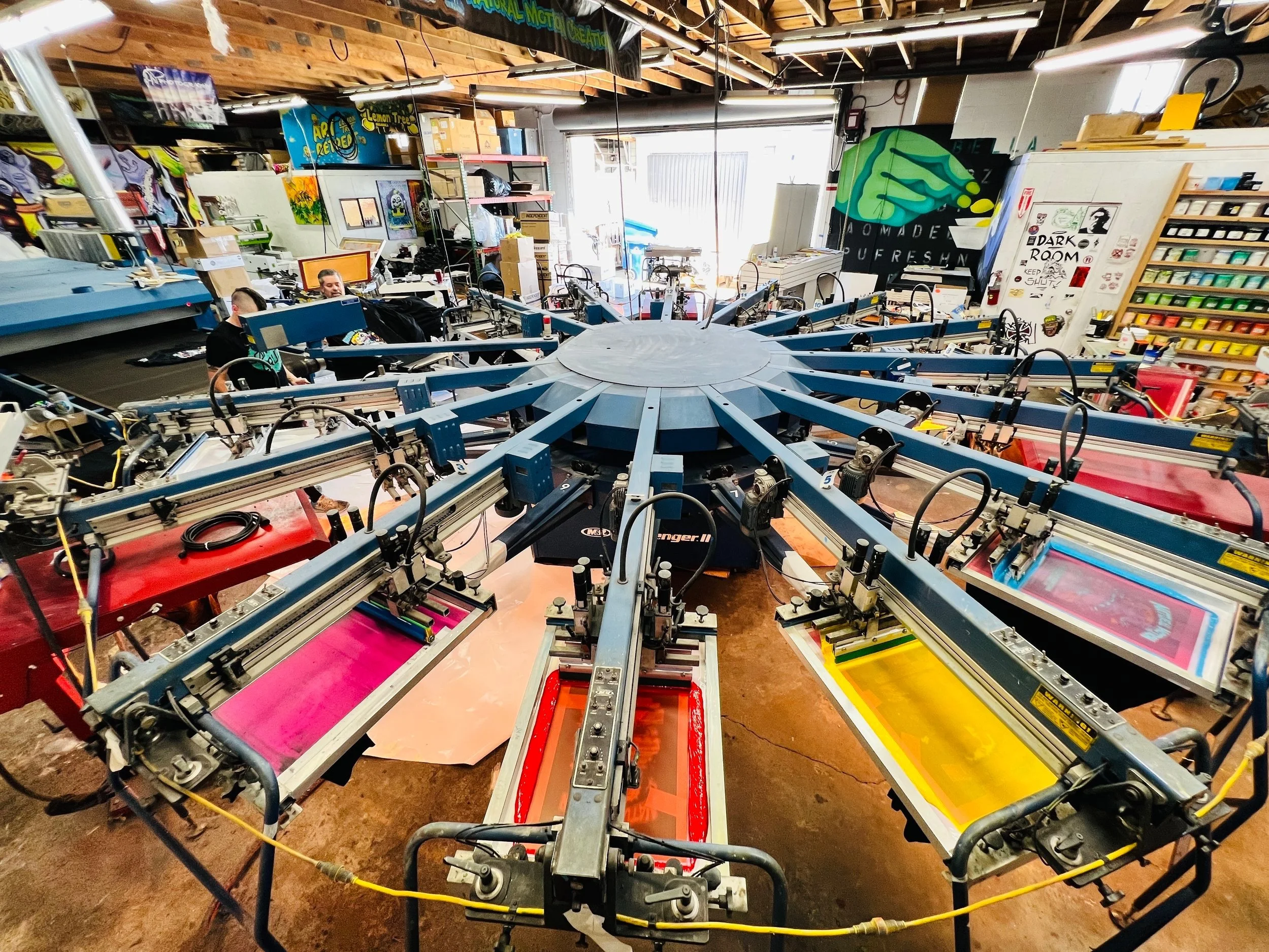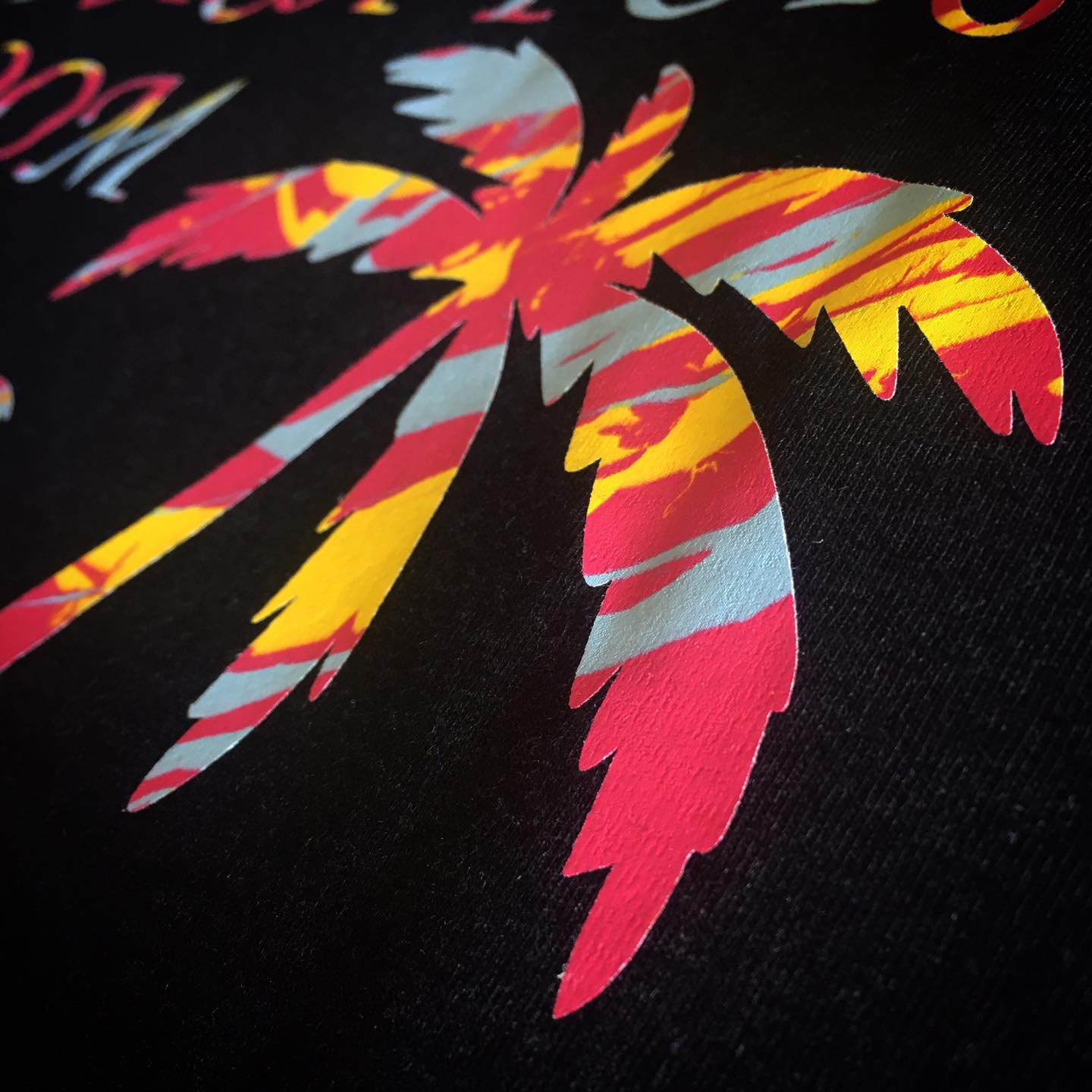Silk Screen Printing for Bold and Lasting Designs
Wiki Article
Screen Printing Uncovered: Every Little Thing You Required to Find Out About Tee and Garment Printing Methods
If you've ever before asked yourself just how those lively layouts finish up on your favored tees, you remain in the appropriate location. Display printing is a fascinating approach that combines art with method, offering limitless opportunities for creative thinking. Comprehending the basics, from devices to ink options, can considerably influence your outcomes. Prepared to check out the essential elements that make display publishing an art kind? Allow's discover the information that can boost your jobs.
The Essentials of Screen Printing: How It Functions
When you plunge into display printing, you'll find it's both an art and a science. At its core, display printing includes developing a stencil, or display, that enables ink to pass through just in details locations.Following, you'll blend your inks and prepare your printing surface. Placement the display over the material, after that use a squeegee to press ink via the screen onto the garment. This procedure calls for precision, as you desire clear, vibrant prints. After printing, you'll treat the ink with warmth, guaranteeing it follows the fabric and lasts with cleans. Each action is crucial, and mastering them will certainly boost your screen printing skills, changing simple garments right into distinct, meaningful items.
Kinds of Display Printing Techniques
When you realize the basics of screen printing, it's time to check out the various methods that can elevate your styles. One preferred technique is typical screen printing, where ink is pushed with a stenciled display. This method is excellent for bold, vibrant shades. There's water-based ink printing, which uses a softer feeling and is eco-friendly, but it calls for a various strategy to healing.If you're going for great details, think about discharge printing. This method eliminates dye from the fabric, leaving a soft, vintage appearance. An additional option is plastisol printing, known for its longevity and vibrant shades, making it a preferred for many brands. Lastly, trying out halftone printing to create slope effects and elaborate styles. Each method has its one-of-a-kind beauty, so do not hesitate to attempt them bent on locate what matches your design best!
Vital Equipment for Display Printing
To accomplish magnificent results in display printing, having the appropriate devices is fundamental. You'll require a durable display printing frame, which holds the mesh that moves your layout onto the garment. Next off, invest in top quality mops; these are essential for using ink equally across the display.Picking the Right Inks and Materials
When selecting inks and materials for screen printing, you need to take into consideration the kind of ink that functions best for your project. Believe concerning fabric compatibility to ensure your layouts look great and last long. Discover green ink alternatives to make your printing process much more sustainable.Sorts Of Screen Inks
Choosing the ideal display ink is necessary for achieving lively, durable prints that meet your project's requirements. There are several types of screen inks to check out. Specialty inks, such as glow-in-the-dark or metallic, can add special results to your designs.
Fabric Compatibility Considerations
Comprehending material compatibility is essential for attaining top quality display prints, specifically given that different materials react distinctively to different inks. When picking inks, consider the material type-- cotton, polyester, or blends. For cotton, water-based inks function well, providing soft qualities and breathability. Polyester, on the various other hand, usually calls for plastisol inks for better adhesion and vibrant shades. If you're publishing on blends, you may need to make use of a mix of both types. Constantly check your inks on sample fabric to assure they adhere correctly and maintain shade honesty. Additionally, bear in mind that material weight and appearance can influence the last result, so picking the ideal ink and product combo is vital for your project's success.Eco-Friendly Ink Options
Eco-friendly inks are becoming a popular choice for screen printers who want to minimize their environmental influence while keeping high quality. When picking inks, think about water-based inks, which are much less unsafe and less complicated to cleanse up contrasted to standard solvents.Additionally, try to find inks made from renewable energies, such as soy or vegetable-based options. By selecting the ideal inks and materials, you'll not only create stunning styles yet additionally add to a much more sustainable printing process. Make the button, and your prints will certainly show your commitment to the atmosphere!
Preparing Your Style for Display Printing

File Format Requirements
To assure your layout looks sharp and vibrant on textile, you'll need to pay attention to submit style demands for screen printing. Begin with vector documents like AI or EPS, as they can be scaled without losing high quality. If you make use of raster images, choose high-resolution files, such as TIFF or PNG, preferably at 300 DPI. Avoid utilizing JPEGs, as they can shed clearness when resized. Make certain your design has a clear background to avoid undesirable white sides on your prints. Ultimately, maintain color settings in mind; CMYK is typical for display printing, so convert your RGB develops accordingly. By adhering to these guidelines, you'll set your artwork up for a successful print.Shade Separation Strategies
Shade splitting up is an important action screen printing kit in preparing your style for screen printing, and mastering it can substantially improve your print high quality. You'll require to break your design right into individual colors, as each color calls for a different display during printing. Start by determining all the colors in your design and develop layers for each one. You can use software like Adobe Photoshop or Illustrator to separate and different shades effectively. Be particular to save each layer as a separate file, typically in a format like TIFF or PSD. This accuracy not just guarantees precise color depiction yet also simplifies the printing process. By focusing on color separation, you'll attain specialist and vibrant lead to your screen-printed garments.Resolution and Dimension
Achieving the ideal lead to display printing begins with ensuring your layout has the best resolution and dimension. Ideally, your art work should go to least 300 DPI (dots per inch) for sharp, clear prints. Your final product may look pixelated and unprofessional. if you make use of lower resolution.When it involves size, think about the measurements of your print area. Layout your artwork to match the last print dimension, ideally developing it in the actual measurements you'll be publishing. By doing this, you'll stay clear of any unanticipated scaling problems.
Constantly inspect your design in both vector and raster formats. Vector graphics can be scaled without losing high quality, making them ideal for screen printing. Preparing properly will ensure your style looks incredible on every garment!
Step-by-Step Screen Printing Process
Screen printing is a dynamic process that allows you to develop vibrant designs on various surfaces. To get started, you'll need a screen, solution, and your selected ink.After cleaning out the unexposed solution, your display prepares. Set it up on your printing surface and align your garment beneath it. Pour ink onto the screen and use a squeegee to press the ink via the pattern onto the fabric. Lift the screen thoroughly and allow the print completely dry. Treat the ink using warmth to ensure sturdiness. That's it! You've successfully display printed your design.
Tips for Successful Screen Printing Projects
While you're diving right into your screen printing tasks, keep in mind that prep work is crucial to success. Start by gathering all your products-- inks, squeegees, garments, and displays. A tidy work area aids stop undesirable errors, so tidy up before you start.Next, confirm your art work is high-resolution and properly sized for your garment. Check your display for appropriate direct exposure and clean it completely to avoid smudges. When blending your inks, adhere to the maker's standards to accomplish the appropriate consistency.
Throughout printing, apply also pressure with your squeegee for regular outcomes. Don't hurry; take your time to confirm each print meets your standards. After printing, let your garments dry totally prior to dealing with or packaging them.
Lastly, always keep a sample of your job for future reference. By doing this, you can assess your progression and enhance your methods over time. Happy printing!

Often Asked Questions
The length of time Does It Require To Establish a Screen Printing Job?
Establishing a screen printing work typically takes about thirty minutes to an hour. You'll prepare the displays, mix inks, and change the press. The moment varies based on intricacy and experience, so stay organized!Can I Publish on Different Textile Types Making Use Of the Very Same Strategy?
Yes, you can print on various material kinds utilizing the very same strategy, however you'll need to change your inks and setups. Some materials absorb ink in different ways, so trying out warranties the best results for each and every material.What Are Typical Mistakes to Stay Clear Of in Screen Printing?
When screen printing, prevent common blunders like utilizing the incorrect ink, disregarding proper direct exposure times, or avoiding pre-press checks. Constantly examine your setup and preserve tidy displays to guarantee high quality results each time.How Can I Appropriately Tidy and Preserve My Display Printing Tools?
To effectively tidy and keep your screen printing tools, you need to consistently wash displays with proper solvents, check squeegees for wear, and ensure all devices are saved dust-free and dry. Consistency stops costly repair services and boosts performance.Is Display Printing Environmentally Pleasant Contrasted to Other Methods?
Screen printing can be more eco pleasant than various other approaches, specifically if you utilize water-based inks and eco-conscious materials. By selecting sustainable products and techniques, you minimize waste and reduce your effect on the earth.Display Printing Uncovered: Whatever You Need to Know Regarding Tee and Garment Printing Strategies
At its core, display printing entails producing a stencil, or display, that allows ink to pass through only in details areas. Position the display over the material, after that make use of a squeegee to press ink with the screen onto the garment. One prominent technique is traditional screen printing, where ink is pressed through a stenciled screen.When picking inks and products for screen printing, you require to take into account the kind of ink that works best for your task.
Report this wiki page